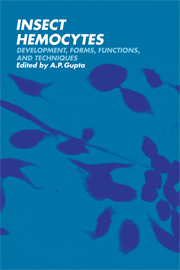Book contents
- Frontmatter
- Contents
- Preface
- List of contributors
- Part I Development and differentiation
- Part II Forms and structure
- 4 Hemocyte types: their structures, synonymies, interrelationships, and taxonomic significance
- 5 Surface and internal ultrastructure of hemocytes of some insects
- 6 Fine structure of hemocyte membranes and intercellular junctions formed during hemocyte encapsulation
- 7 Controversies about the coagulocyte
- 8 Controversies about hemocyte types in insects
- 9 Hemocyte cultures and insect hemocytology
- 10 Pathways and pitfalls in the classification and study of insect hemocytes
- Part III Functions
- Part IV Techniques
- Indexes
4 - Hemocyte types: their structures, synonymies, interrelationships, and taxonomic significance
Published online by Cambridge University Press: 04 August 2010
- Frontmatter
- Contents
- Preface
- List of contributors
- Part I Development and differentiation
- Part II Forms and structure
- 4 Hemocyte types: their structures, synonymies, interrelationships, and taxonomic significance
- 5 Surface and internal ultrastructure of hemocytes of some insects
- 6 Fine structure of hemocyte membranes and intercellular junctions formed during hemocyte encapsulation
- 7 Controversies about the coagulocyte
- 8 Controversies about hemocyte types in insects
- 9 Hemocyte cultures and insect hemocytology
- 10 Pathways and pitfalls in the classification and study of insect hemocytes
- Part III Functions
- Part IV Techniques
- Indexes
Summary
Introduction
Hemocytes of arthropods and several other invertebrate groups have been studied (see Gupta, 1979). Among arthropods, they have been most extensively studied in insects, followed by crustaceans, arachnids, and myriapods. Hemocytes of a few onychophorans also have been described. It is not surprising, therefore, that the need for a reliable, uniform classification of various hemocyte types has been felt more keenly by insect hematologists than by those of other arthropod groups. Fortunately, a generally acceptable hemocyte classification in insects, based largely on morphological characteristics, now exists.
Hemocyte classifications both in insects and other arthropods have been variously based on morphology, functions, and staining or histochemical reactions of hemocytes. Thus, it is not unusual to find the same hemocyte type or its various forms being referred to by different names in various arthropods, by different authors – a situation that has inevitably resulted in a confusing mass of terminology. Consequently, it becomes very difficult to compare hemocytes of one species with those of others. This has particularly hindered any phylogenetic consideration of the evolution of hemocyte types in various arthropod groups and the Onychophora. Clearly, there is a need for a uniform hemocyte classification for insects as well as other arthropod groups. The insect hemocyte classification that is generally used has evolved over more than half a century. According to Millara (1947), Cuenot (1896) was the first to classify insect hemocytes into four categories and was later followed in this attempt by Hollande (1909, 1911) and others. Wigglesworth (1939) summarized most of the earlier classifications and presented a classification that was widely accepted. He modified it later (Wigglesworth, 1959).
- Type
- Chapter
- Information
- Insect HemocytesDevelopment, Forms, Functions and Techniques, pp. 85 - 128Publisher: Cambridge University PressPrint publication year: 1979
- 44
- Cited by



